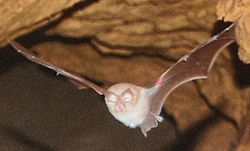| Rhinolophoidea | |
|---|---|
 | |
| Rhinolophus euryale | |
| Scientific classification | |
| Kingdom: | Animalia |
| Phylum: | Chordata |
| Class: | Mammalia |
| Order: | Chiroptera |
| Suborder: | Yinpterochiroptera |
| Superfamily: | Rhinolophoidea Gray, 1825 |
| Families [1] | |
Rhinolophoidea is a superfamily of bats. It contains the following families: Craseonycteridae, Hipposideridae, Megadermatidae, Rhinolophidae, Rhinonycteridae, and Rhinopomatidae. [1] [2] It is one of two superfamilies that comprise the suborder Yinpterochiroptera, the other being Pteropodoidea, which only contains the family Pteropodidae. [3]



